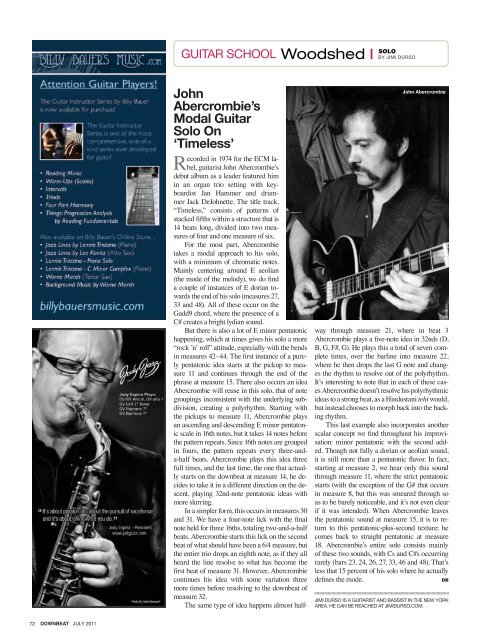Wessell Anderson Gerry Hemingway Dave Stryker John ... - Downbeat
Wessell Anderson Gerry Hemingway Dave Stryker John ... - Downbeat
Wessell Anderson Gerry Hemingway Dave Stryker John ... - Downbeat
Create successful ePaper yourself
Turn your PDF publications into a flip-book with our unique Google optimized e-Paper software.
72 DOWNBEAT JULY 2011<br />
soLo<br />
GUITAR SCHOOL Woodshed | BY JiMi DurSo<br />
<strong>John</strong><br />
Abercrombie’s<br />
Modal Guitar<br />
Solo on<br />
‘Timeless’<br />
Recorded in 1974 for the ECM label,<br />
guitarist <strong>John</strong> Abercrombie’s<br />
debut album as a leader featured him<br />
in an organ trio setting with keyboardist<br />
Jan Hammer and drummer<br />
Jack De<strong>John</strong>ette. The title track,<br />
“Timeless,” consists of patterns of<br />
stacked fifths within a structure that is<br />
14 beats long, divided into two measures<br />
of four and one measure of six.<br />
For the most part, Abercrombie<br />
takes a modal approach to his solo,<br />
with a minimum of chromatic notes.<br />
Mainly centering around E aeolian<br />
(the mode of the melody), we do find<br />
a couple of instances of E dorian towards<br />
the end of his solo (measures 27,<br />
33 and 48). All of these occur on the<br />
Gadd9 chord, where the presence of a<br />
C# creates a bright lydian sound.<br />
But there is also a lot of E minor pentatonic<br />
happening, which at times gives his solo a more<br />
“rock ’n’ roll” attitude, especially with the bends<br />
in measures 42–44. The first instance of a purely<br />
pentatonic idea starts at the pickup to measure<br />
11 and continues through the end of the<br />
phrase at measure 15. There also occurs an idea<br />
Abercrombie will reuse in this solo, that of note<br />
groupings inconsistent with the underlying subdivision,<br />
creating a polyrhythm. Starting with<br />
the pickups to measure 11, Abercrombie plays<br />
an ascending and descending E minor pentatonic<br />
scale in 16th notes, but it takes 14 notes before<br />
the pattern repeats. Since 16th notes are grouped<br />
in fours, the pattern repeats every three-anda-half<br />
beats. Abercrombie plays this idea three<br />
full times, and the last time, the one that actually<br />
starts on the downbeat at measure 14, he decides<br />
to take it in a different direction on the descent,<br />
playing 32nd-note pentatonic ideas with<br />
more slurring.<br />
In a simpler form, this occurs in measures 30<br />
and 31. We have a four-note lick with the final<br />
note held for three 16ths, totaling two-and-a-half<br />
beats. Abercrombie starts this lick on the second<br />
beat of what should have been a 6/4 measure, but<br />
the entire trio drops an eighth note, as if they all<br />
heard the line resolve to what has become the<br />
first beat of measure 31. However, Abercrombie<br />
continues his idea with some variation three<br />
more times before resolving to the downbeat of<br />
measure 32.<br />
The same type of idea happens almost half-<br />
<strong>John</strong> Abercrombie<br />
way through measure 21, where in beat 3<br />
Abercrombie plays a five-note idea in 32nds (D,<br />
B, G, F#, G). He plays this a total of seven complete<br />
times, over the barline into measure 22,<br />
where he then drops the last G note and changes<br />
the rhythm to resolve out of the polyrhythm.<br />
It’s interesting to note that in each of these cases<br />
Abercrombie doesn’t resolve his polyrhythmic<br />
ideas to a strong beat, as a Hindustani tehi would,<br />
but instead chooses to morph back into the backing<br />
rhythm.<br />
This last example also incorporates another<br />
scalar concept we find throughout his improvisation:<br />
minor pentatonic with the second added.<br />
Though not fully a dorian or aeolian sound,<br />
it is still more than a pentatonic flavor. In fact,<br />
starting at measure 2, we hear only this sound<br />
through measure 11, where the strict pentatonic<br />
starts (with the exception of the G# that occurs<br />
in measure 8, but this was smeared through so<br />
as to be barely noticeable, and it’s not even clear<br />
if it was intended). When Abercrombie leaves<br />
the pentatonic sound at measure 15, it is to return<br />
to this pentatonic-plus-second texture; he<br />
comes back to straight pentatonic at measure<br />
18. Abercrombie’s entire solo consists mainly<br />
of these two sounds, with Cs and C#s occurring<br />
rarely (bars 23, 24, 26, 27, 33, 46 and 48). That’s<br />
less that 15 percent of his solo where he actually<br />
defines the mode. DB<br />
JIMI DURSO IS A GUITARIST AND BASSIST IN THE NEW YORK<br />
AREA. HE CAN BE REACHED AT JIMIDURSO.COM.<br />
Jørgen Bo

















